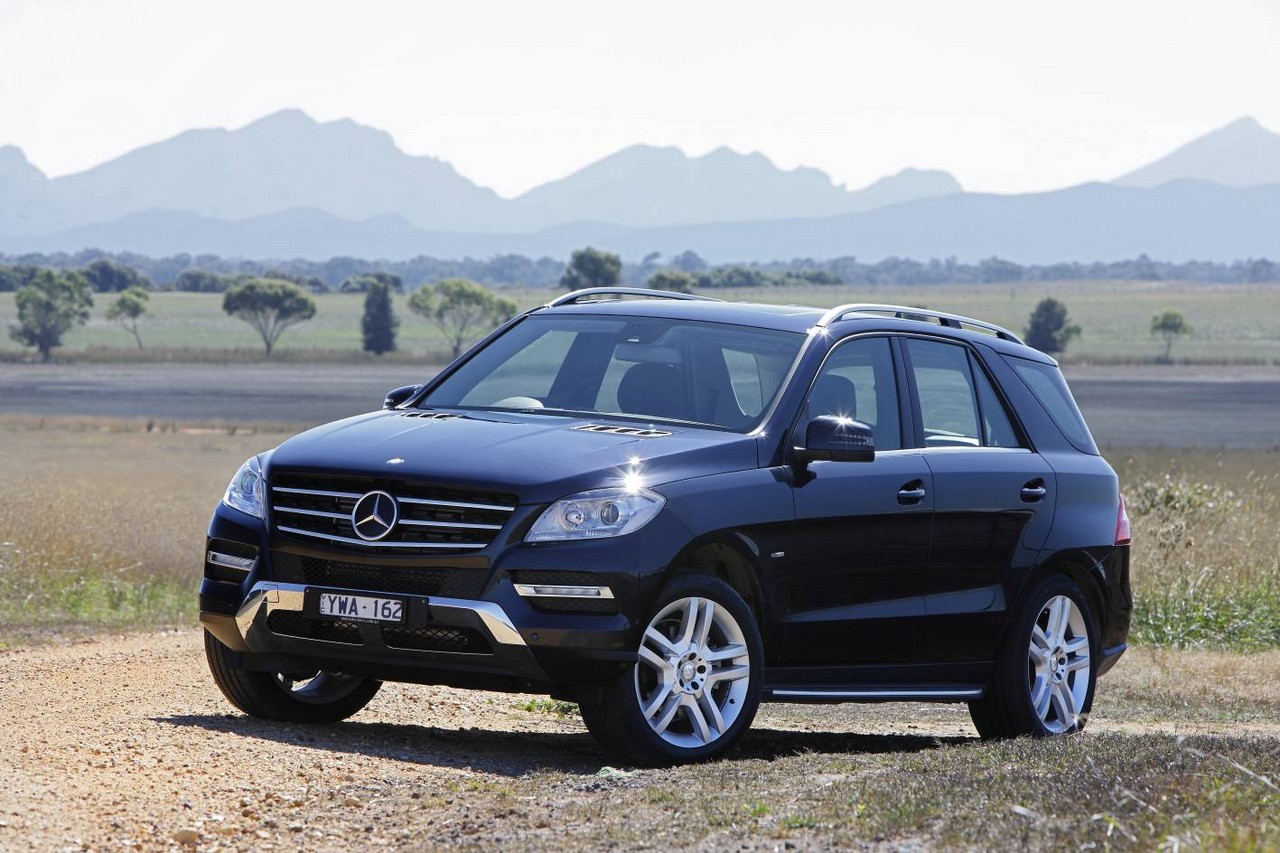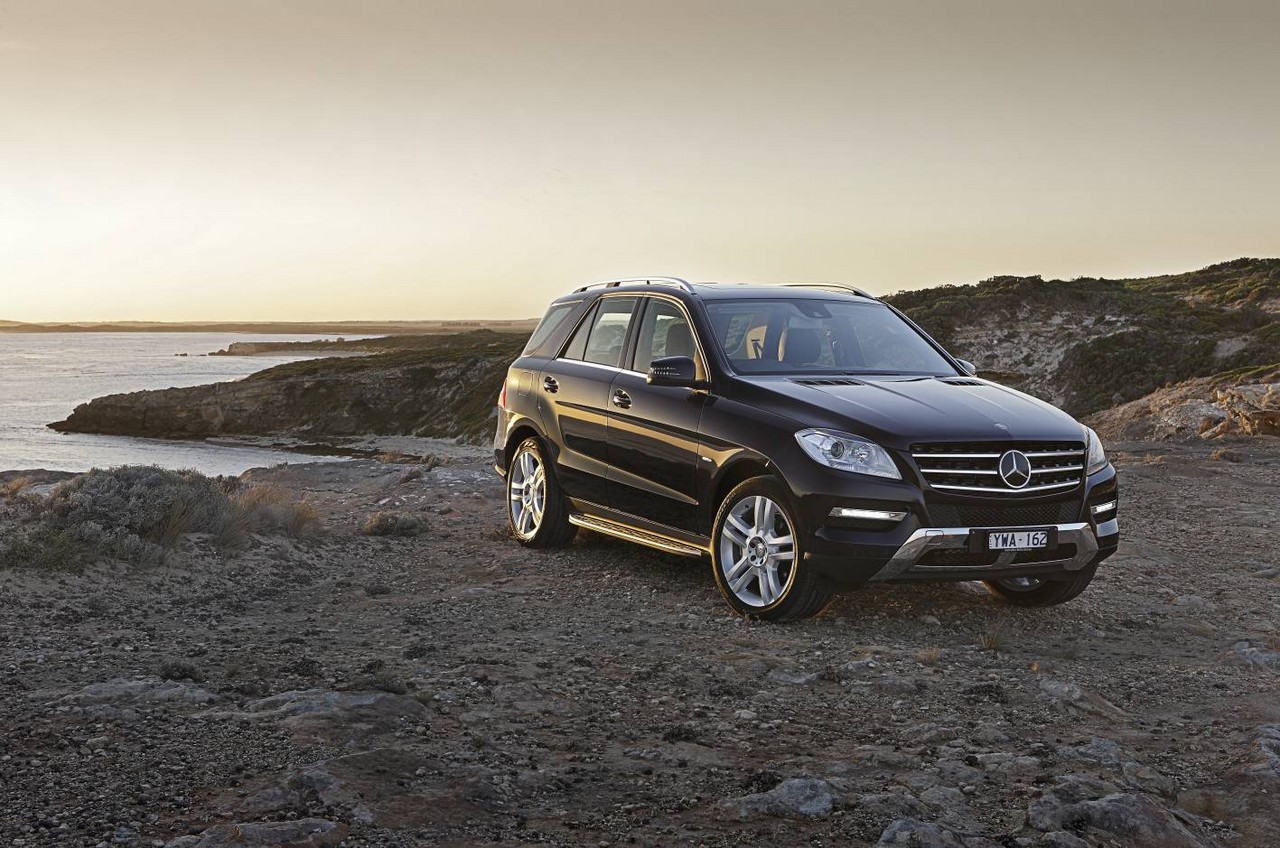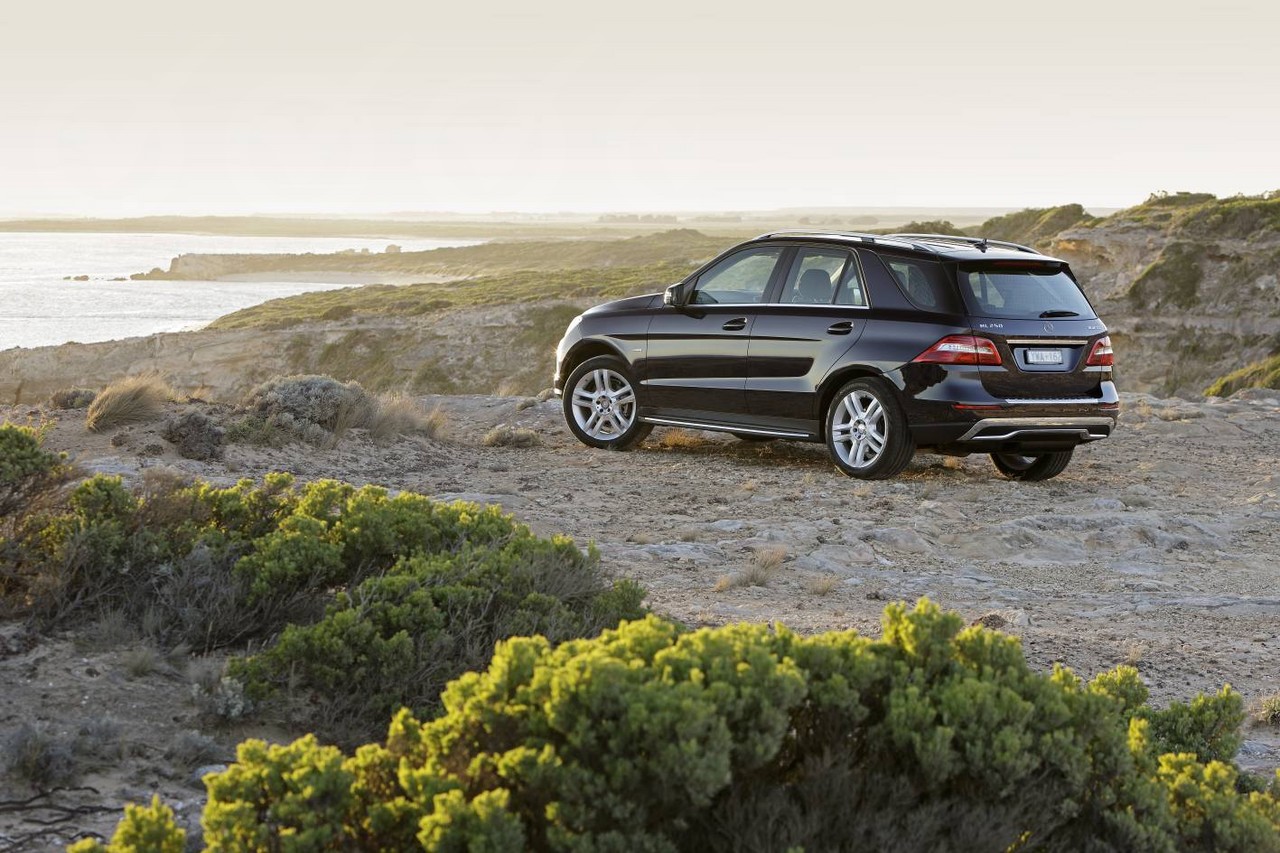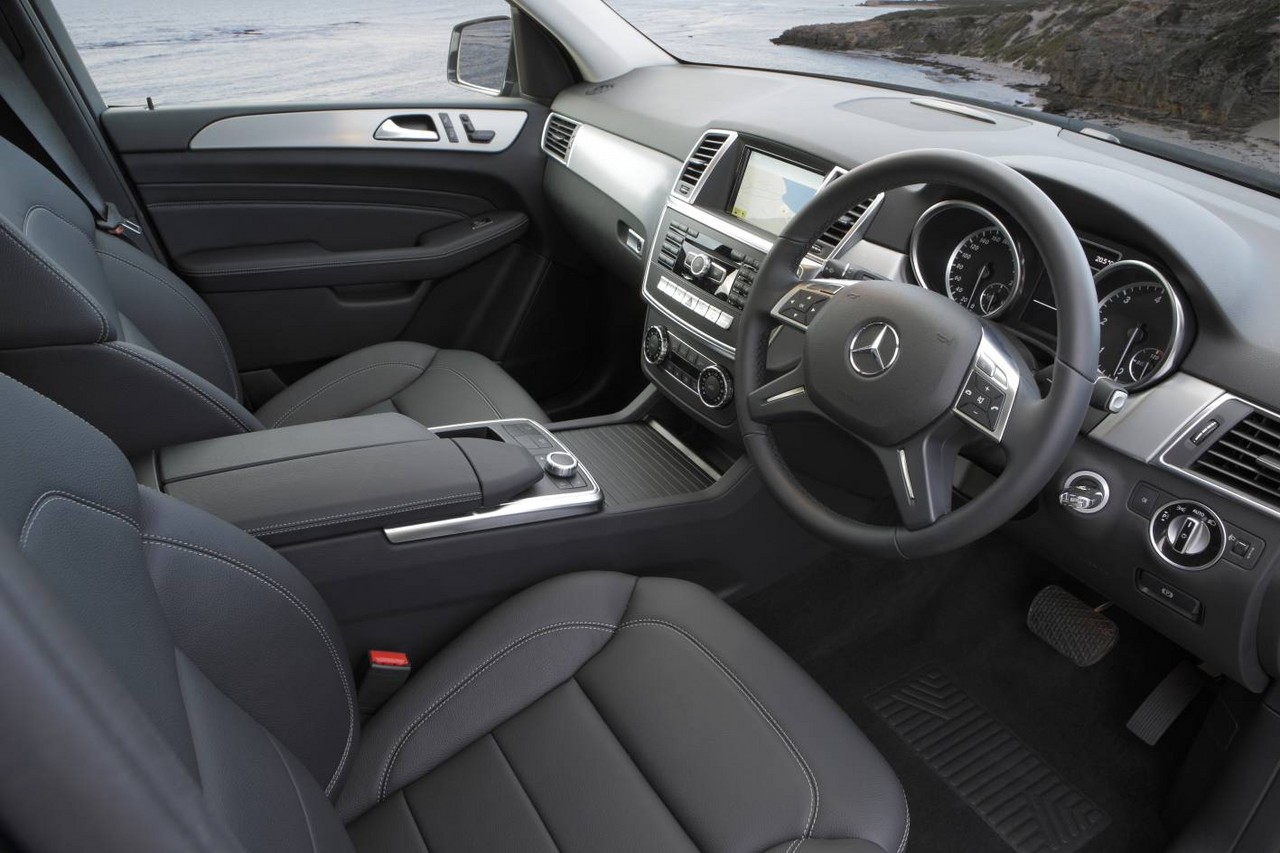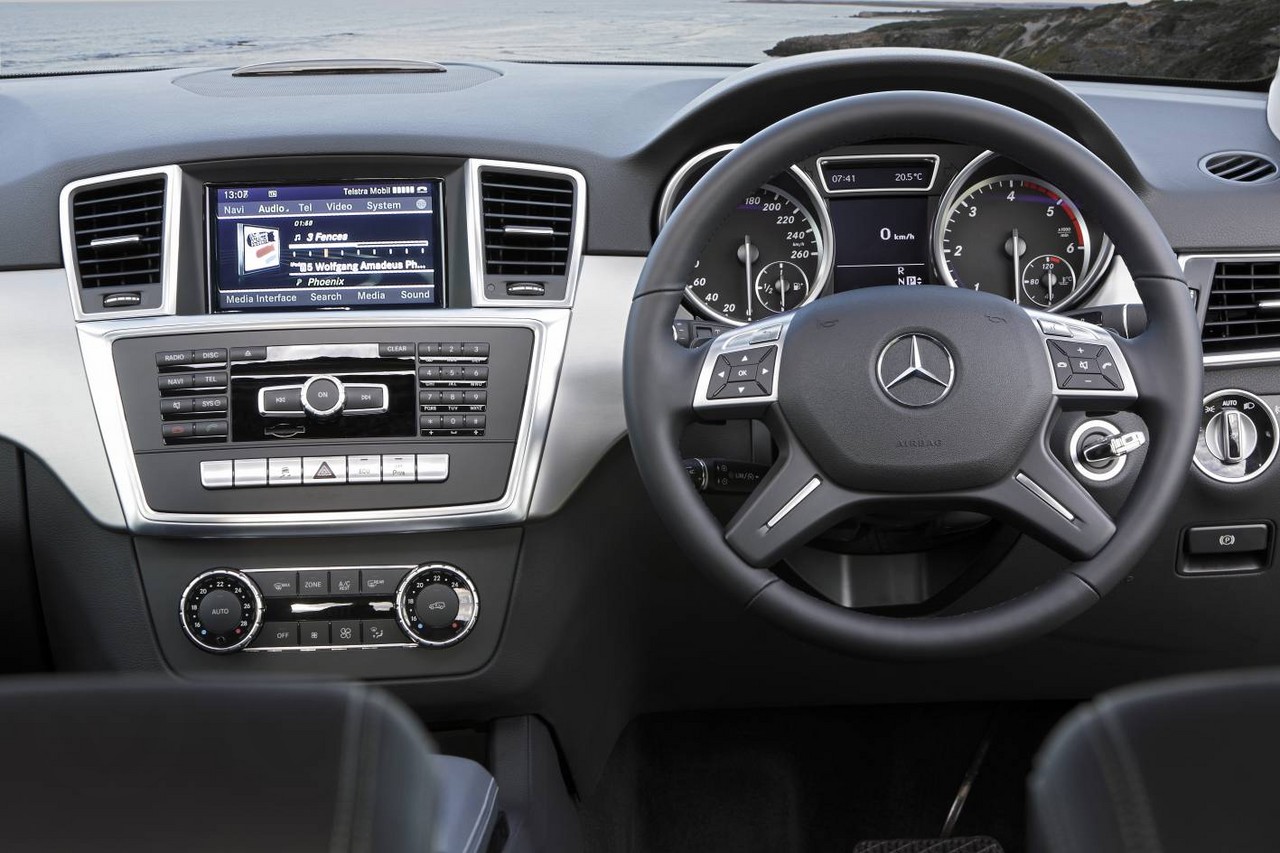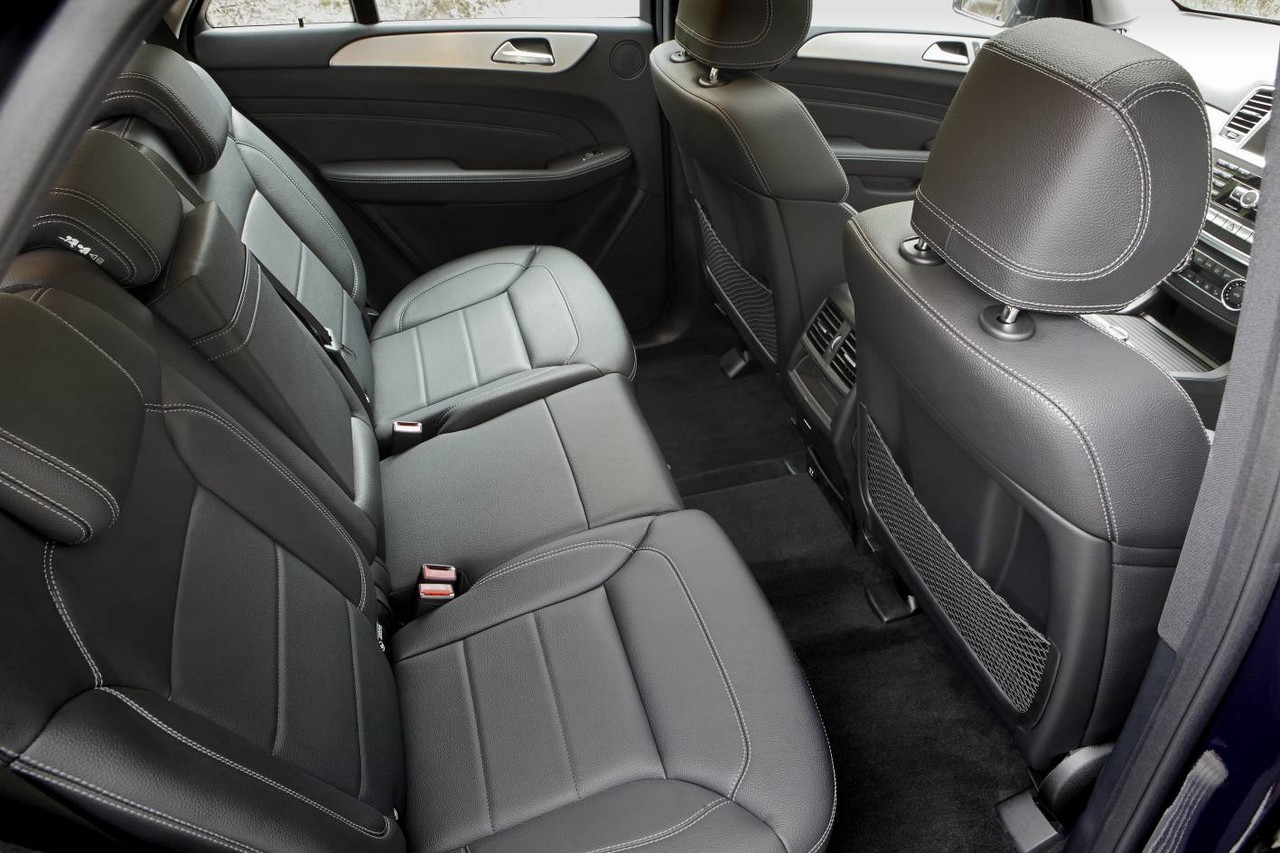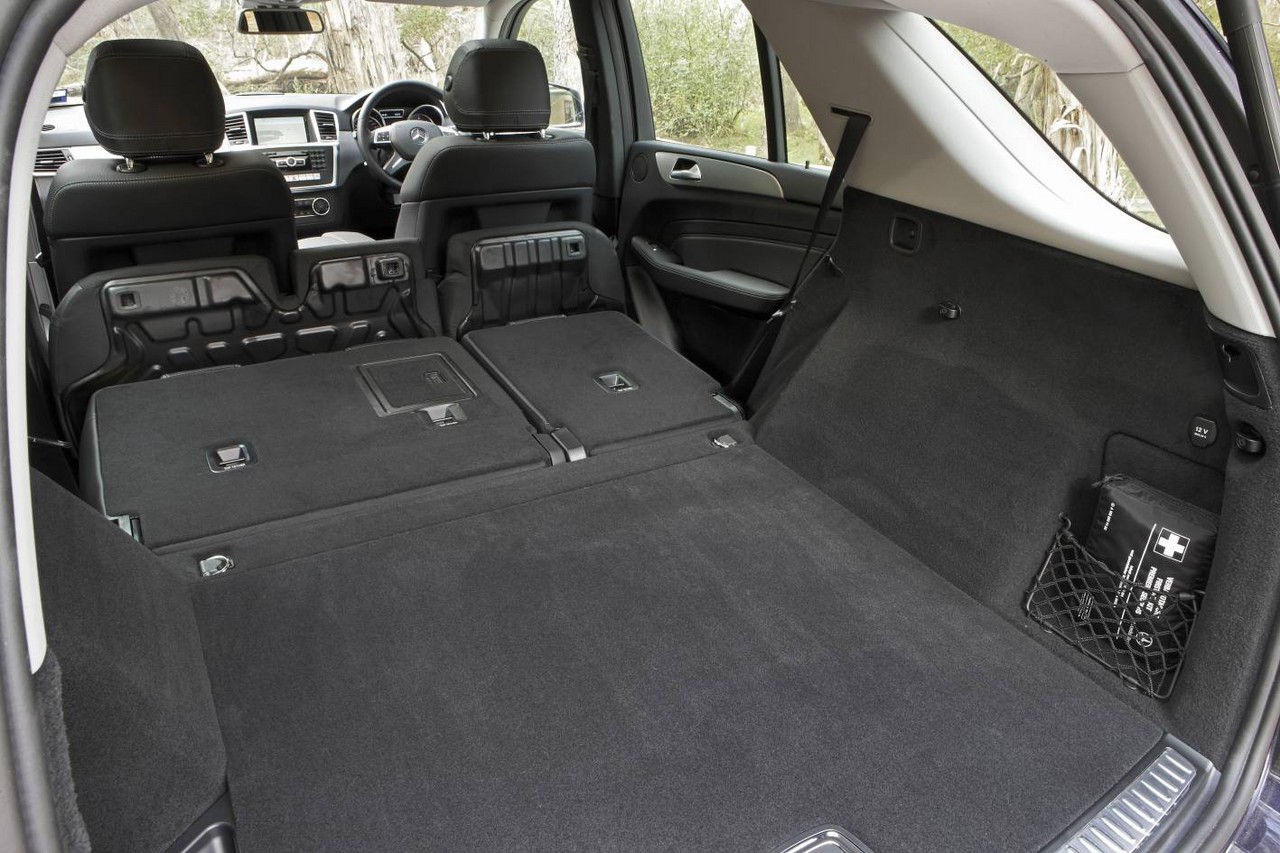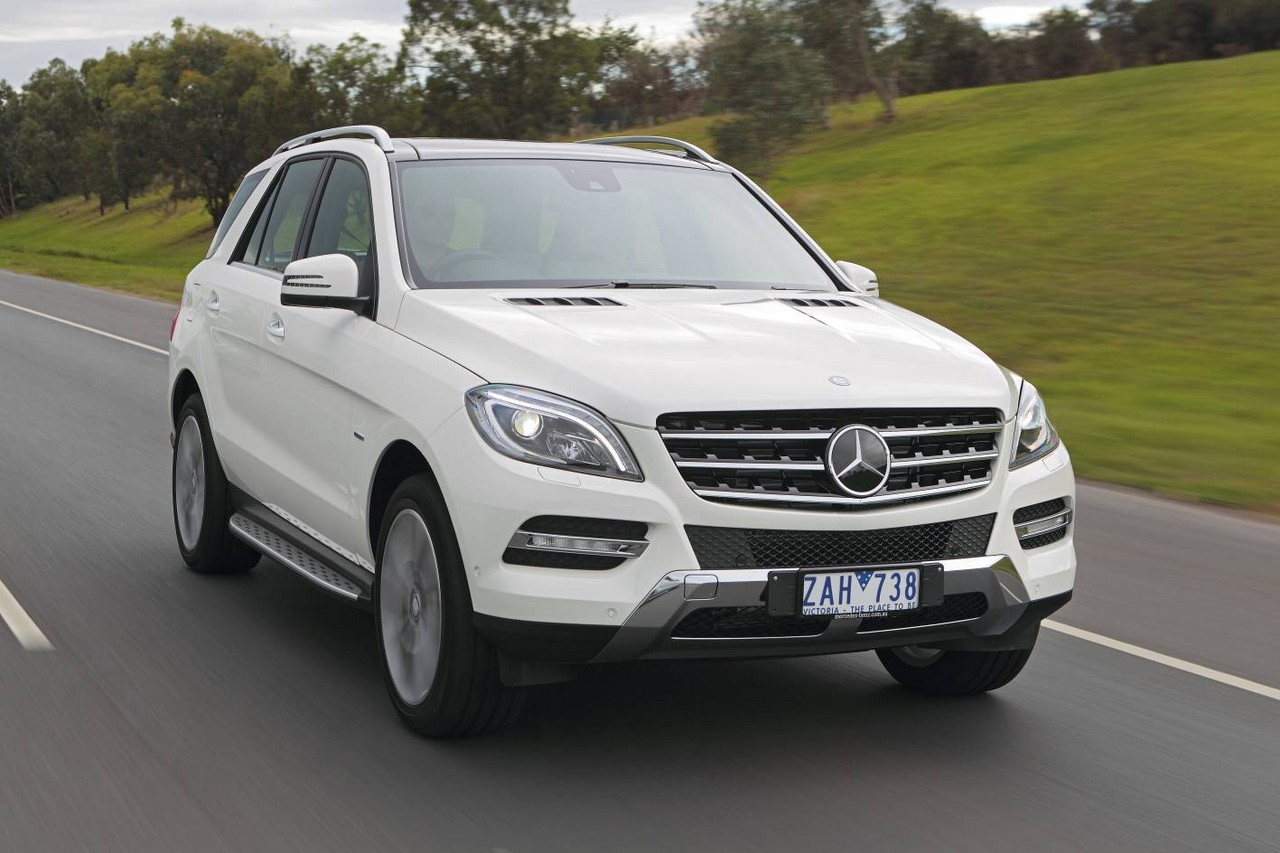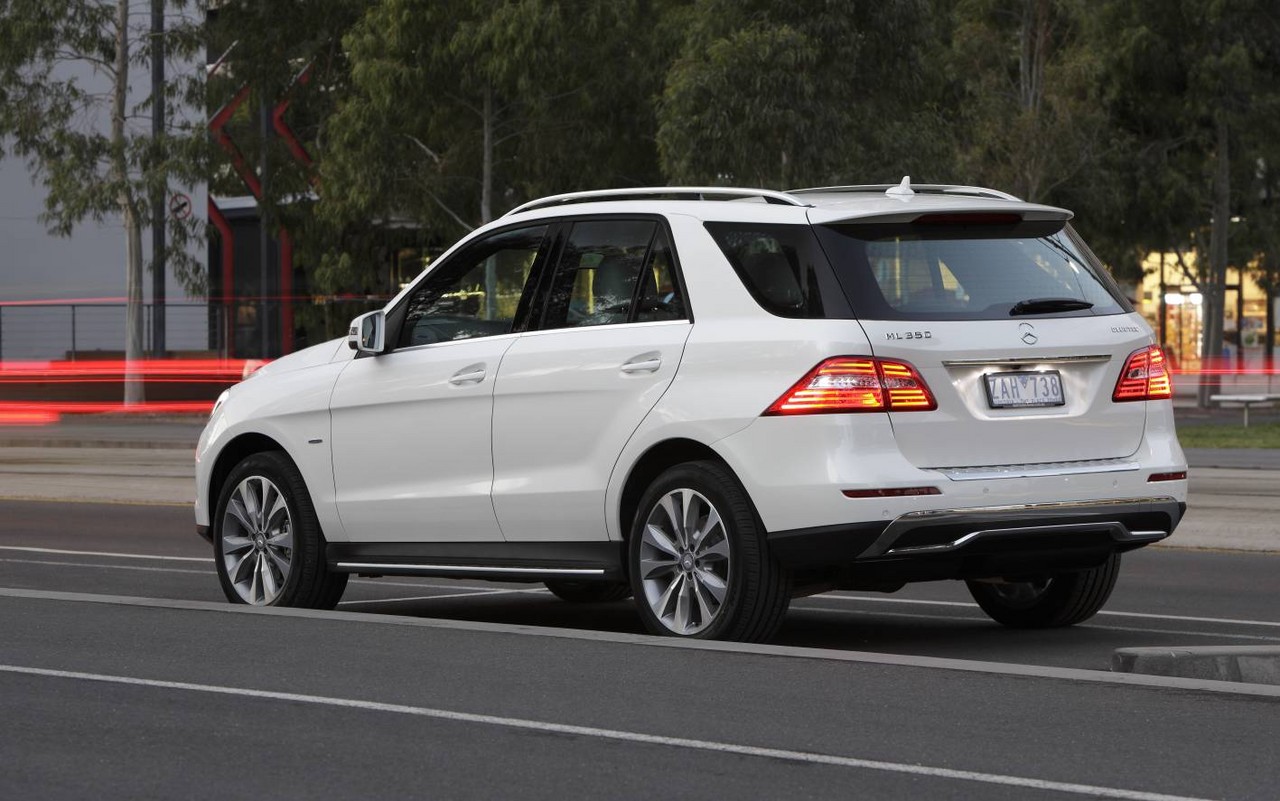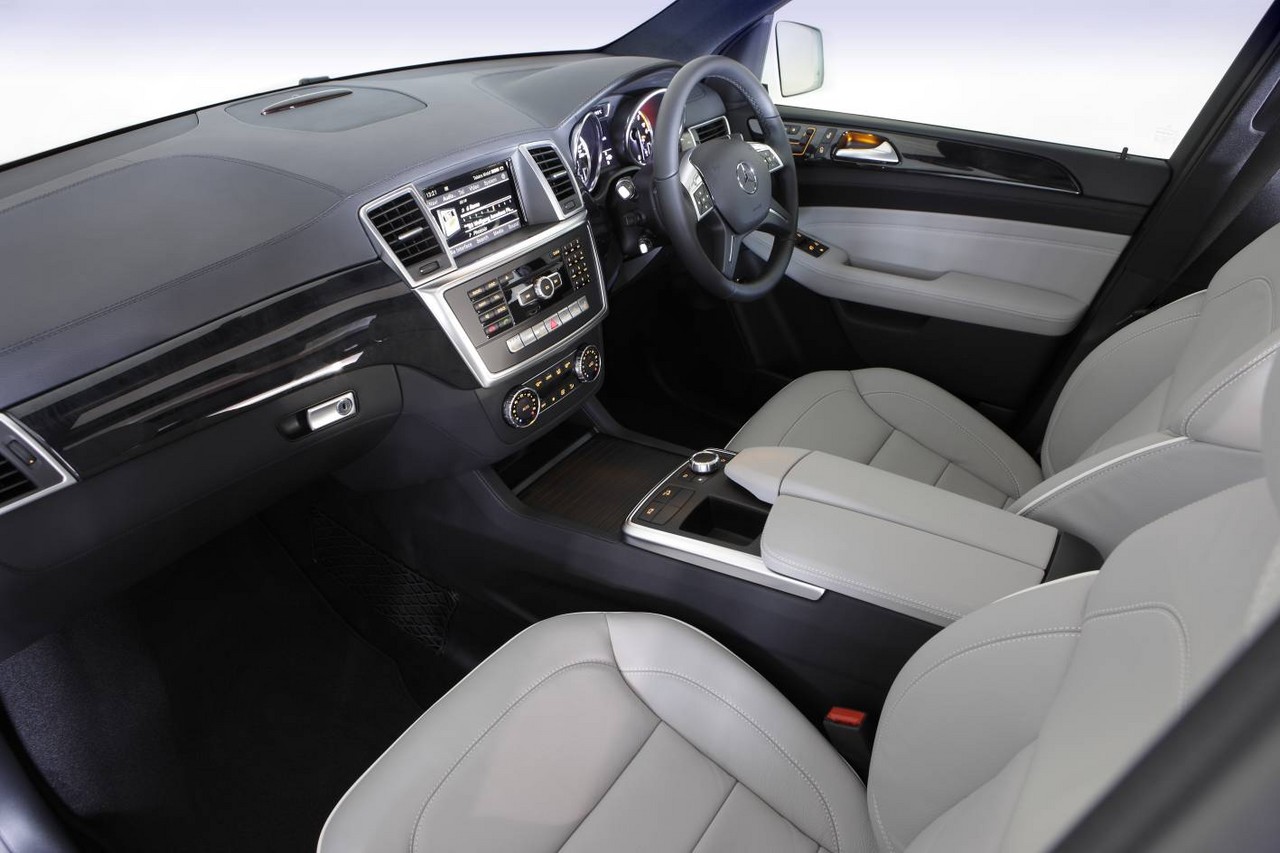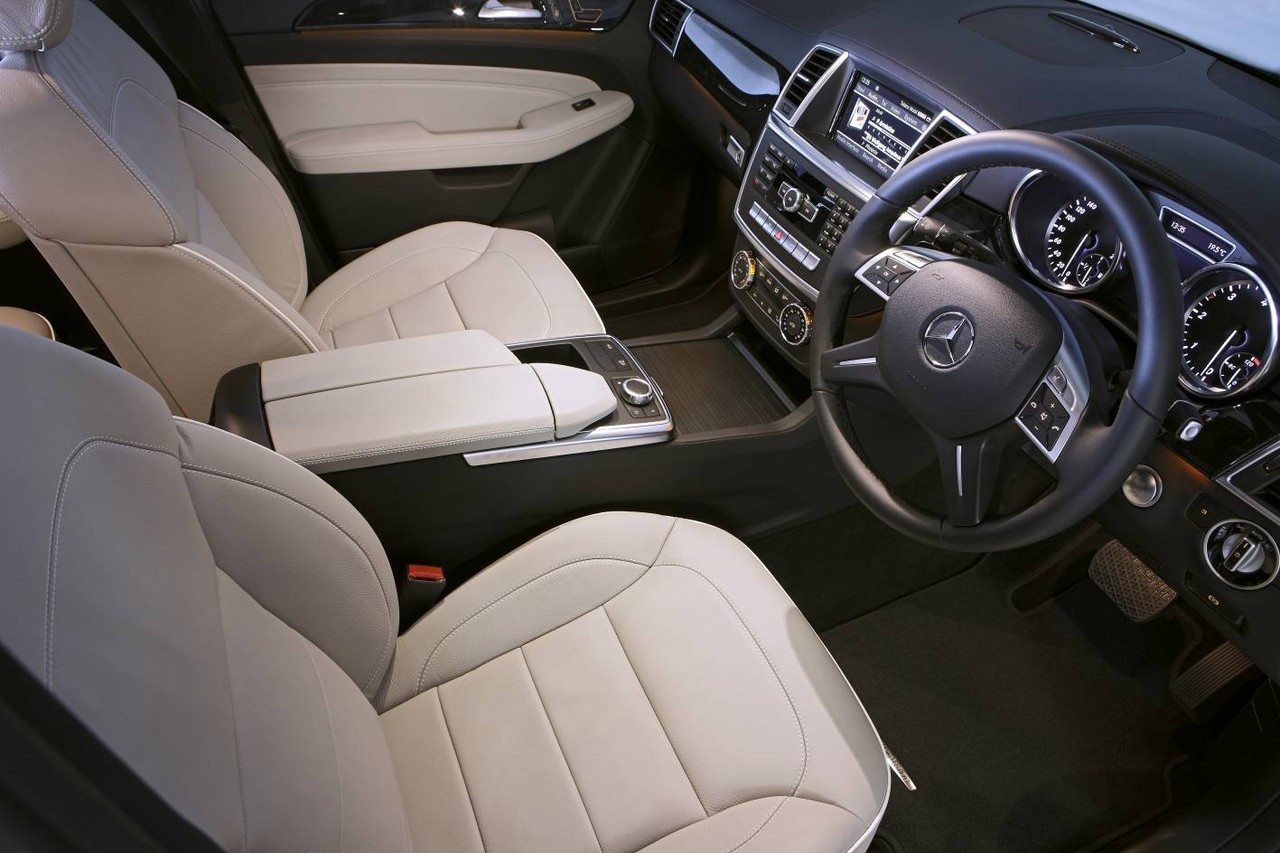
- Fuel-efficient turbo-diesel engines
- Comfortable ride
- High standard of interior fit and finish
- Quiet, well-insulated cabin
- Light steering lacks feel
- For BlueTEC engines, automatic transmissions can be indecisive
- For 2.1-litre OM651 turbo-diesel engine , reports of premature simplex timing chain and/or chain tensioner wear
Overview
Released in May 2012, the Mercedes-Benz W166 M-Class was a large, four-wheel drive SUV. Manufactured in Tuscaloosa, Alabama, the W166 M-Class range initially consisted of the ML 250 BlueTec, ML 350 BlueTec models and ML 350 BlueEfficiency models, with the ML 500 following in September 2012, respectively. For 2014, the ML 350 BlueEfficiency was replaced by the ML 400.
Please note that the Mercedes W166 ML 63 AMG has been reviewed separately.
According to Mercedes-Benz, the W166 M-Class range was 25 per cent more fuel efficient – on average – than the W164 M-Class due to its low drag coefficient (0.32 Cd), low-friction axle drives, electric steering and low rolling resistance tyres. The ML 250 BlueTec and ML 350 BlueTec were also fitted with ‘ECO start/stop’ which enabled the engine to shut down when the vehicle was stationary in traffic.
| Years | Engine | Trans. | Peak power | Peak torque | |
|---|---|---|---|---|---|
| ML 250 BlueTec | 2012-15 | 2.1-litre twin-turbo diesel I4 (OM651) | 7sp auto | 150 kW at 4200 rpm | 500 Nm at 1600-1800 rpm |
| ML 350 BlueTec | 2012-15 | 3.0-litre turbo-diesel V6 (OM642) | 7sp auto | 190 kW at 3600 rpm | 620 Nm at 1600-2400 rpm |
| ML 350 | 2012-13 | 3.5-litre petrol V6 (M276) | 7sp auto | 225 kW at 6500 rpm | 370 Nm at 3500-5250 rpm |
| ML 400 | 2014-15 | 3.0-litre bi-turbo petrol V6 (M276) | 7sp auto | 245 kW at 5250-6000 rpm | 480 Nm at 1400-4000 rpm |
| ML 500 | 2012-15 | 4.7-litre twin-turbo petrol V8 (M278) | 7sp auto | 300 kW at 5000-5750 rpm | 600 Nm at 1600-4750 rpm |
4MATIC four-wheel drive system
The Mercedes-Benz W166 M-Class had a full-time four-wheel drive system (‘4MATIC’) with open differentials. In normal conditions, the 4MATIC system provided a 50:50 front:rear torque split. In the event that any wheel lost traction, the four-wheel traction control system (‘4ETS’) would brake that spinning wheel so that torque would be transferred to the wheels with grip.
Features of the 4MATIC system included:
- Downhill Speed Regulation (DSR): designed for steep downhill gradients and activated by pushing a button in the centre console. With DSR, vehicle speed would be kept constant by engine and transmission control, and automatic braking. While the system would initially set a speed of 6 km/h, the driver could use the cruise control stalk to set the desired downhill speed between 4 km/h (minimum) and 18 km/h (maximum); and,
- Start-Off Assist: helped the vehicle more safely accelerate from rest when on steep uphill gradients, by preventing the vehicle from rolling bac kWards as the driver moved their foot from the brake pedal to the accelerator. During this period, brake pressure would be provided by an ‘actively controllable’ brake servo unit. Start-Off Assist was automatically activated by an inclination sensor.
The ML 350 BlueTec, ML 350 BlueEfficiency and ML 500 were also fitted with an off-road transmission mode in which:
- Wheel slip thresholds and gearshift points for the transmission were raised;
- A flatter accelerator response curve provided more sensitive throttle control; and,
- Off-road ABS settings which would, at regular intervals, apply the front brakes with sufficient force to lock the front wheels so that they would dig into the loose surface and come to a halt more readily.
On & Offroad package
As an extra-cost option, the W166 M-Class was available with an ‘On & Offroad’ package included a two-stage transfer case with reduction gear, an inter-axle differential lock, enhanced Airmatic functionality (for ground clearance of 285 mm and maximum fording depth of 600 mm) and an underguard.
Furthermore, six driving modes that could be selected using a rotary control in the centre console:
- Automatic: a drive mode for a wide range of conditions;
- Offroad 1: for light terrain, tracks and driving over fields;
- Offroad 2: for more challenging off-road terrain with climbs;
- Winter: for roads affected by freezing rain, snow or ice, or with snow chains;
- Sport: for dynamic driving an winding roads; and,
- Trailer: when towing a trailer, ‘Trailer’ mode optimised start-off, manoeuvring and braking characteristics.
Body and dimensions
Compared to the Mercedes-Benz W164 M-Class , the W166 M-Class was 24 mm longer (at 4804 mm), 15 mm wider (19226 mm) and 19 mm lower (1796 mm), though wheelbase length was unchanged (2915 mm). According to Mercedes-Benz, the W166 M-Class also provided greater refinement through measures including:
- Greater front end rigidity and hybrid construction of the front module;
- A rigid magnesium alloy cockpit cross member; and,
- A high-insulation acoustic windscreen.
Cargo capacity for the W166 M-Class was 690 litres with the rear seats in position, though this increased to 2010 litres when they were folded down.
Suspension
The Mercedes-Benz W166 M-Class had double wishbone front suspension and multi-link rear suspension. For models with the standard steel-sprung suspension, selective dampers were fitted which the shock absorbers to vary their damping characteristics according to road surface and vehicle speed.
Airmatic, Adaptive Damping System and Active Curve System
The Mercedes-Benz W166 ML 500 was fitted with Mercedes-Benz’s ‘Airmatic’ air suspension with Adaptive Damping System (ADS) which consisted of:
- Air-filled spring struts on the front axle with integral ADS dampers;
- Air springs with separate ADS dampers on the rear axle;
- Electric compressor with central pressure reservoir and pressure sensor;
- Air spring valves;
- Sensors for level control and damping control; and,
- An electronic control unit.
Airmatic air suspension could compensate for variations in vehicle load and driving state, while also acting as a level control system. For off-road use, Airmatic enabled the suspension to be raised for greater ground clearance; at higher speeds, the suspension could be lowered for aerodynamic efficiency.
ADS was a fully automatic, electronically-controlled system which adapted the damping force at each wheel according to the road and driver behavior to reduce the forces exerted on the body by the movement of the wheels; the driver could also select from ‘Comfort’ and ‘Sport’ modes. ADS had four maps which it could use based on steering angle, turning angle sensors, vehicle speed and braking application:
- Level 1: soft rebound and soft compression for comfortable ride characteristics, suitable for little longitudinal and lateral acceleration;
- Level 2: soft rebound and firm compression (skyhook mode);
- Level 3: firm rebound and soft compression (skyhook mode);
- Level 4: firm rebound and firm compression, for minimising wheel load fluctuations when cornering and braking for more secure handling.
While Level 1 would be used for low levels of body movement, greater movement would result in the skyhook algorithm alternating between Levels 2 and 3 – by activating the fast-acting solenoid valves – to counter body roll and pitch. In more ‘dynamic’ handling conditions or when the ‘Sport’ suspension mode was engaged, Level 4 would be used.
The ML 500 was also fitted with Mercedes-Benz’s ‘Active Curve System’ which used active anti-roll bars on the front and rear axles to control body roll according to lateral acceleration, road speed and the suspension mode selected. For more information on the Active Curve System, please see the W166 ML 63 AMG review .
Steering
The Mercedes-Benz W166 M-Class had electric rack-and-pinion steering with speed-sensitive power assistance.
Safety equipment
Standard safety equipment for the Mercedes-Benz W166 M-Class included dual front airbags, a driver’s knee airbag, front and rear side airbags, full-length curtain airbags, ABS, electronic brake force distribution, brake assist, electronic stability control, traction control, active front seat head restraints, front seatbelts with pre-tensioners and load limiters, driver fatigue monitoring (‘Attention Assist’) and an ‘active bonnet’ which would rise in the event of a pedestrian collision to cushion the pedestrian’s subsequent impact with the bonnet.
As standard, the W166 M-Class was also fitted with:
- Pre-Safe: in the event that an accident was anticipated, Pre-Safe would prepare the vehicle by tensioning the front seat belts, inflating the air cushions in the multicontour seats and closing the sunroof and windows (if open); and,
- Collision Prevention Assist: a radar-based system which operated at speeds above 7 km/h and provided visual and acoustic warnings to alert the driver if obstacles were identified on the road ahead and prepared the brakes for optimum braking response.
The ML 350 BlueTec, ML 350 BlueEfficiency, ML 400 and ML 500 were further equipped with:
- Distronic Plus (adaptive cruise control with brake warning): an ‘adaptive’ cruise control system which used two short-range radar sensors positioned behind the front bumper to monitor the road up to 30 metres ahead, and a long-range radar located behind the radiator grille which had a range of 200 metres. Operating at speeds up to 200 km/h, Distronic Plus used an electronic control unit to analyse the information from both radar systems to calculate the engine, automatic transmission and braking parameters required for proximity control. As such, Distronic Plus could automatically apply the brakes to prevent the vehicle from becoming too close to traffic ahead (the time interval could be specified) and accelerate back to the set speed when traffic allowed. To accelerate from rest, the driver only needed to operate the Distronic stalk on the steering column or briefly depress the accelerator pedal. With Distronic Plus, automatic deceleration of up to four (4) m/s2was possible. If Distronic Plus detected that heavier braking was required, a warning light would illuminate in the instrument cluster and be accompanied by an audible warning. Furthermore, the electronic proximity control system could be activated independently of Distronic Plus at speeds over 30 km/h to alert the driver if they were approaching another vehicle too rapidly;
- Brake Assist Plus: used a 24 GHz radar sensor with a range of 30 metres and a 77 GHz radar sensor with a range of 200 metres to monitor the distance to the vehicle ahead and would warn the driver if there was a risk of a collision. Brake Assist Plus could detect vehicles when travelling at speeds up to 200 km/h, and stationary objects when the driver was travelling at 7 km/h to 72 km/h. Significantly, Brake Assist Plus could calculate the necessary brake force assistance to prevent a rear-end collision, build up that pressure in the braking system and provide it as soon as the brake pedal was depressed for ‘the best possible deceleration’;
- Pre-Safe Brake (autonomous emergency braking): using two 24 GHz sensors behind the front bumper which had a range of 30 metres and a 77 GHz radar which had a range of 200 metres, Pre-Safe Brake operated at speeds between 30 km/h and 200 km/h, and at speeds below 70 km/h if the vehicle was approaching a stationary queue of traffic. Around 2.6 seconds before the anticipated moment of impact, an audible warning would sound and a red warning would appear in the tachometer. Around 1.6 before the calculated impact, the first stage of Pre-Safe Brake would initiate partial braking autonomously with around 40 per cent of the maximum braking power (approximately four (4) m/s2); the Pre-Safe occupant protections system would also be activated. If the driver then applied the brakes, maximum braking force would be made available. If the driver failed to react, Pre-Safe Brake would – in its second stage – initiate autonomous emergency braking (i.e. maximum braking power) around 0.6 seconds before the unavoidable collision to reduce the severity of the impact;
- Active Lane Keeping Assist: could detect when the adjacent lane was occupied (including oncoming traffic) and prevent the driver from inadvertently exiting from the lane when it was not safe to do so by applying a corrective braking force to the wheels on one side of the vehicle; and,
- Active Blind Spot Assistance: active at speeds above 60 km/h, a corrective braking force would be applied to the wheels on one side of the vehicle if the driver attempted to change lanes when a vehicle was detected in the driver’s blind spot.
Euro NCAP testing
In Euro NCAP testing , a Mercedes-Benz W166 ML 350 BlueTec received a five star safety rating which included a 96 per cent adult occupant protection rating and a 75 per cent child occupant protection rating. In the offset crash test, there was a slight risk of serious chest injury for the front occupants and a slight risk of serious leg injury for the front passenger. Maximum points were awarded in the side impact test and, in the more severe pole test, protection of the chest was assessed as adequate and all other body areas as good. Under ANCAP’s methodology , this testing resulted in a five star adult occupant protection rating with a score of 36.34 out of 37.
Features: Mercedes-Benz W166 ML 250 BlueTec
Standard features for the Mercedes-Benz W166 ML 250 included 19-inch five-spoke alloy wheels, an eight speaker sound system, Mercedes-Benz’s COMAND APS (Cockpit Management and Data System) with a single disc CD/DVD player, MP3/WMA/AAC compatibility, auxiliary inputs (3.5mm/USB/iPod), 17.8cm TFT colour display, HDD navigation, 10GB music storage, voice recognition, Bluetooth connectivity and internet connectivity, dual-zone climate control air conditioning, power adjustable front seats, Artico synthetic leather upholstery, cruise control, front and rear parking sensors, a reversing camera (with dynamic guide lines), autonomous reverse parking (‘Parktronic’), rain-sensing wipers, a leather-wrapped steering wheel with gearshift paddles, 1/3 to 2/3 split and folding rear seats, remote central locking, power windows and heated mirrors, a height and reach adjustable steering wheel, a power-operated park brake, 12 volt power outlets, tyre pressure monitoring and an immobiliser.
Features: ML 350 BlueTec, ML 350, ML 400 and ML 500
The Mercedes-Benz W166 ML 350 BlueTec, ML 350 BlueEfficiency and ML 400 were further equipped with 20-inch ten-spoke alloy wheels, genuine leather upholstery, heated front seats, directional and adaptive bi-xenon headlights, memory settings (front seats, steering column and mirrors), power folding mirrors, electrochromatic door and rear view mirrors and ambient lighting.
The W166 ML 500 was distinguished by its added 20-inch AMG five-spoke alloy wheels, proximity key, a power-operated tailgate and power-operated glass sunroof.
Mercedes-Benz W166 ML 250 BlueTEC Special Edition
In January 2014, a limited-run ML 250 BlueTEC Special Edition was released. Compared to the standard ML 250 BlueTec, the Special Edition featured 20-inch alloy wheels, heated front seats, bi-xenon headlights and a 360 degree camera; safety equipment was also extended with the inclusion of a Lane Tracking Package with Blind Spot Assist.
Brochure
Related links
- Press Kit: Mercedes-Benz W166 M-Class (September 2011)
- Press Kit: Mercedes-Benz W166 M-Class (April 2012)
- Specifications: Mercedes-Benz W166 M-Class (July 2014)
- Mercedes-Benz Australia: Mercedes-Benz M-Class
- Wikipedia.org: Mercedes-Benz W166 M-Class
- Behind the Wheel: 2012 Mercedes-Benz M-Class Review
